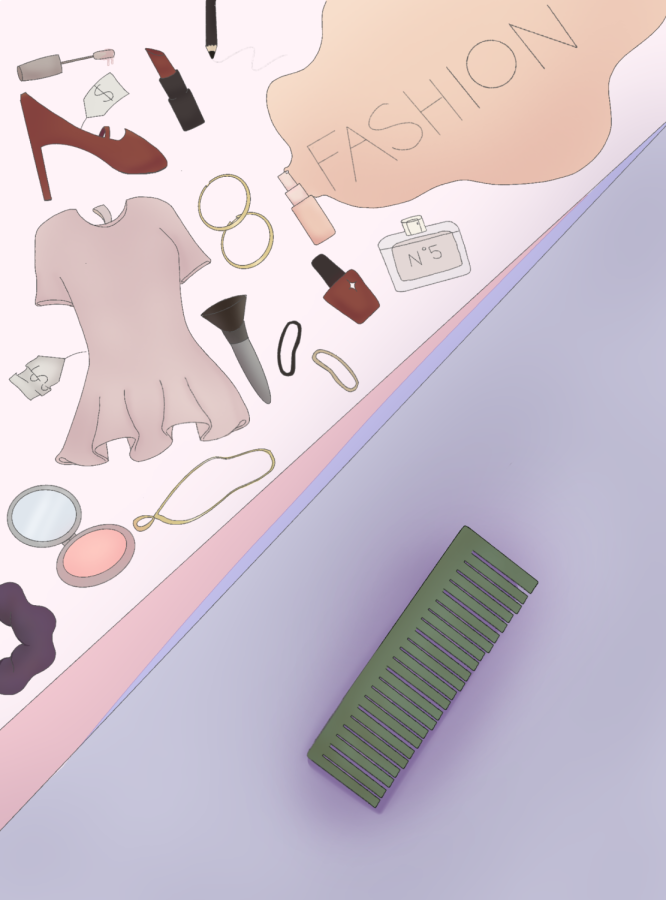Popular Fashion is Filled With Double Standards
June 3, 2022
You walk into a shopping mall and the first thing you see is… fashion. The latest bags, shoes, and throwback pants are displayed in every shop window, making you jealous of the model-bodied mannequins. But how much of that is women’s fashion? Practically all of it, right?
American Eagle, H&M, Urban Outfitters, all the most popular fashion brands have a massive section of clothes designed for female consumers. The guys section, of course, is a small corner in the back. The reasoning behind this is evident; women are the most loyal and constant fashion consumers on the planet, purchasing considerably more of almost all types of clothing than their male counterparts, as per a study by an industry research website. A wider variety of clothes can only lead to more customers and bigger purchases. But have we ever stopped to consider why women are such bigger consumers of fashion than men? (freedoniafocusreports.com).
Fashion has been long deemed a female preoccupation. Whereas men can put on some sweatpants and a hoodie and call it a day, women are expected to dress their best no matter the occasion. But, of course, young girls have to walk a tightrope within that; if you wear anything resembling traditionally male attire or that covers up most of your body, you’re deemed a prude. But if you embrace your femininity “too much” (whatever that means), you’re deemed promiscuous.
As trends come and go (most of which target younger women in particular), men aren’t the ones expected to stay caught up. And when women are rocking the latest fashion attire, they’re quickly dismissed as “basic” or “unoriginal” by the very people who encourage them to keep up with pop culture’s obsessions. On the other hand, the guy who follows trends is everyone’s favorite. As you can see, this mindset offers no winning situation.
According to data by the Pew Research Center, 35 percent of surveyed individuals believe physical attractiveness to be the trait society values most in women, this being sixth on the list of men’s most valued traits. Comments and critiques about body types only worsen the situation, adding to the many insecurities young women face in our modern world. The pressure to pursue these ideals is a caging practice we must eradicate (pewresearch.org).
Mass media continues to push the unhealthy and unrealistic anatomical ideals society has long asked women to meet in order to be considered pretty. Photoshopped pictures that contrast both curves and flat abdomens hugely impact our image of beauty, making it seem unattainable and limited to particular traits. “The media pushes the idea of individuality being the most interesting thing a person can do, while in turn creating a kind of conformity to certain identities,” said Sophomore Áine Govil.
On top of that, women’s clothing is notably costlier. According to a financial education website, the average cost of a pair of women’s jeans is 62.75 dollars, while the average pair of men’s jeans is 57.09 dollars. That’s a difference of over five dollars. The same is true for almost all other pieces of clothing, with men only paying more for underwear (howmuch.net).
Junior Amelia Rains concurred that there are evident double standards between men and women’s fashion. “Just look at any Met Gala and you can see the extreme effort women put into dressing and being inventive with clothes, compared to men’s rotation of a black or navy blue suit,” she commented.
Sophomore Andrea Lanatta-Valera said, “I see these expectations at school all the time. Girls always stroll around with nice outfits and makeup on while guys walk around in shorts and a t-shirt.” As for the origin of this, Lanatta-Valera stated that caring about fashion “…isn’t perceived as a very ‘masculine’ thing to do.”
The evident disparity between societal views of women’s and men’s fashion has long left an indelible mark. An important step forward could be achieved by both raising the bar for men’s fashion codes and normalizing the comfort-over-style mentality fellas have long adopted for all. Govil said, “… if we can look past shallow niceties and really get to know each other, conformity to these standards wouldn’t be an issue.”



Andrew • Apr 30, 2023 at 12:44 pm
I know Andrea Lanatta-Valera isn’t speaking complete truth. For instance about the part that fashion isn’t a masculine thing to do is a false statement. This is why avant garde fashion exists. Nearly everything in mainstream women’s fashion during these current feminism times has been already done by men before, which is why society now cheers on the girl with cowboy hat, short shorts, and tall cowboy boots. That outfit obviously didn’t exist 100 years ago when real cowgirls like Annie Oakley were making history. All those mentioned fashion items were worn by men first. Same with ugg boots(World War 1 British pilotmen), thigh high/otk boots (medieval-renaissance european horseriding men), heels (persian horseridering men then King Louis XIV), hoisery and arm warmers(first seen on ancient Egyptian kings), tunics(Roman men), shorts and short shorts(British men), skirts/kilts(Roman & Scottish men), even Mary Jane shoes are a knock off Kung Fu shoes. The list of clothing items that were worn by men first continues but it’s countless to write them all down. Men popularized these fashion items during the peak eras of chivalry and masculinity and now modern feminism fashion brought these itemes over to give a hint of masculinity to their outfits which empowers their well-being. Now in order for men to stay relevant they have to create new variations of these items which would be classified avant-garde. Those men’s thigh-high high platform boots by Rick Owens in 2021 is what I mean by the latter statement and same with the Gmbh Kaan thigh-high boots in 2022.
Thank you for reading this.
aMEN